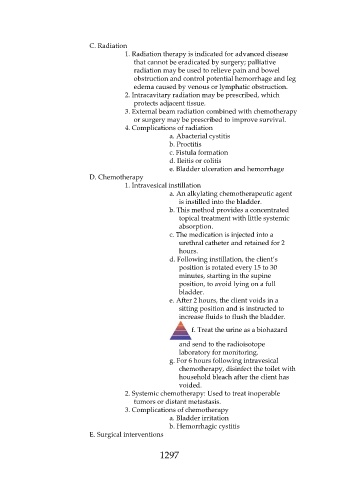Page 1297 - Saunders Comprehensive Review For NCLEX-RN
P. 1297
C. Radiation
1. Radiation therapy is indicated for advanced disease
that cannot be eradicated by surgery; palliative
radiation may be used to relieve pain and bowel
obstruction and control potential hemorrhage and leg
edema caused by venous or lymphatic obstruction.
2. Intracavitary radiation may be prescribed, which
protects adjacent tissue.
3. External beam radiation combined with chemotherapy
or surgery may be prescribed to improve survival.
4. Complications of radiation
a. Abacterial cystitis
b. Proctitis
c. Fistula formation
d. Ileitis or colitis
e. Bladder ulceration and hemorrhage
D. Chemotherapy
1. Intravesical instillation
a. An alkylating chemotherapeutic agent
is instilled into the bladder.
b. This method provides a concentrated
topical treatment with little systemic
absorption.
c. The medication is injected into a
urethral catheter and retained for 2
hours.
d. Following instillation, the client’s
position is rotated every 15 to 30
minutes, starting in the supine
position, to avoid lying on a full
bladder.
e. After 2 hours, the client voids in a
sitting position and is instructed to
increase fluids to flush the bladder.
f. Treat the urine as a biohazard
and send to the radioisotope
laboratory for monitoring.
g. For 6 hours following intravesical
chemotherapy, disinfect the toilet with
household bleach after the client has
voided.
2. Systemic chemotherapy: Used to treat inoperable
tumors or distant metastasis.
3. Complications of chemotherapy
a. Bladder irritation
b. Hemorrhagic cystitis
E. Surgical interventions
1297

